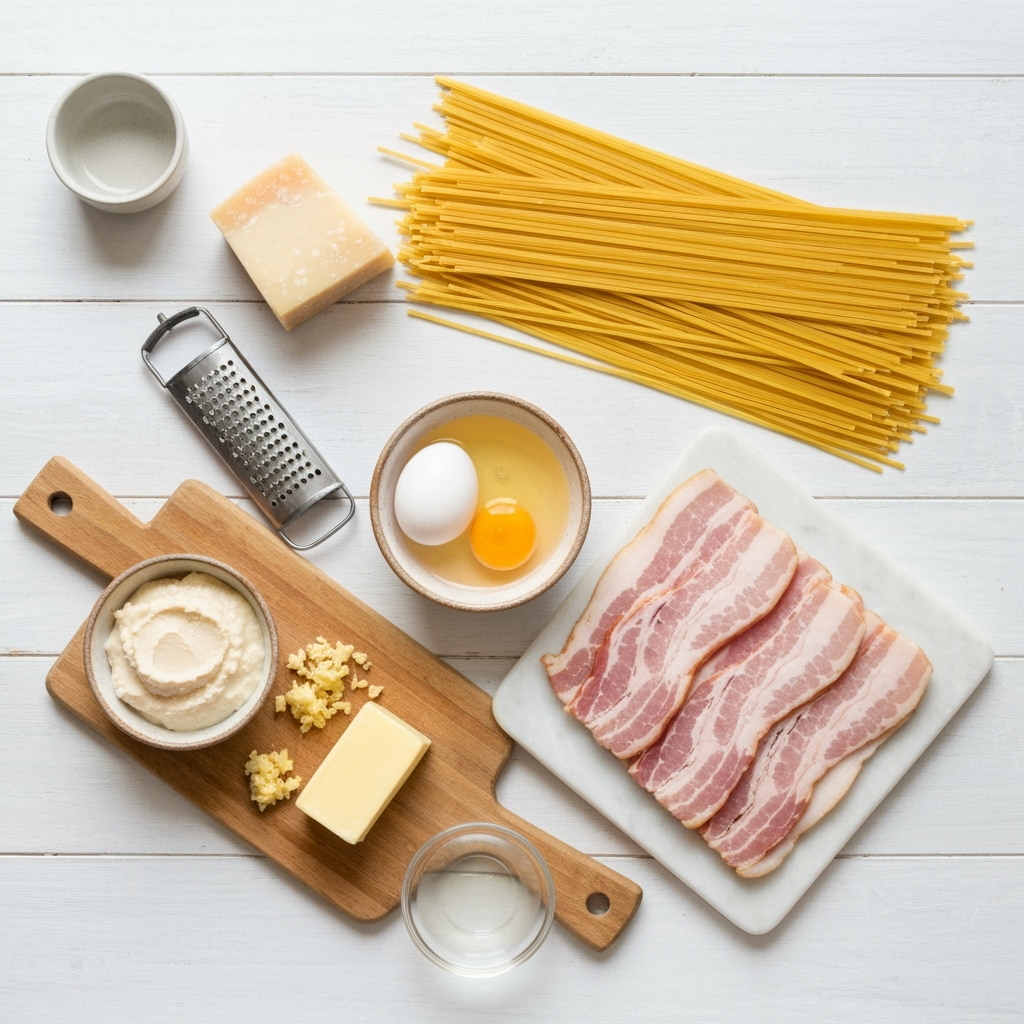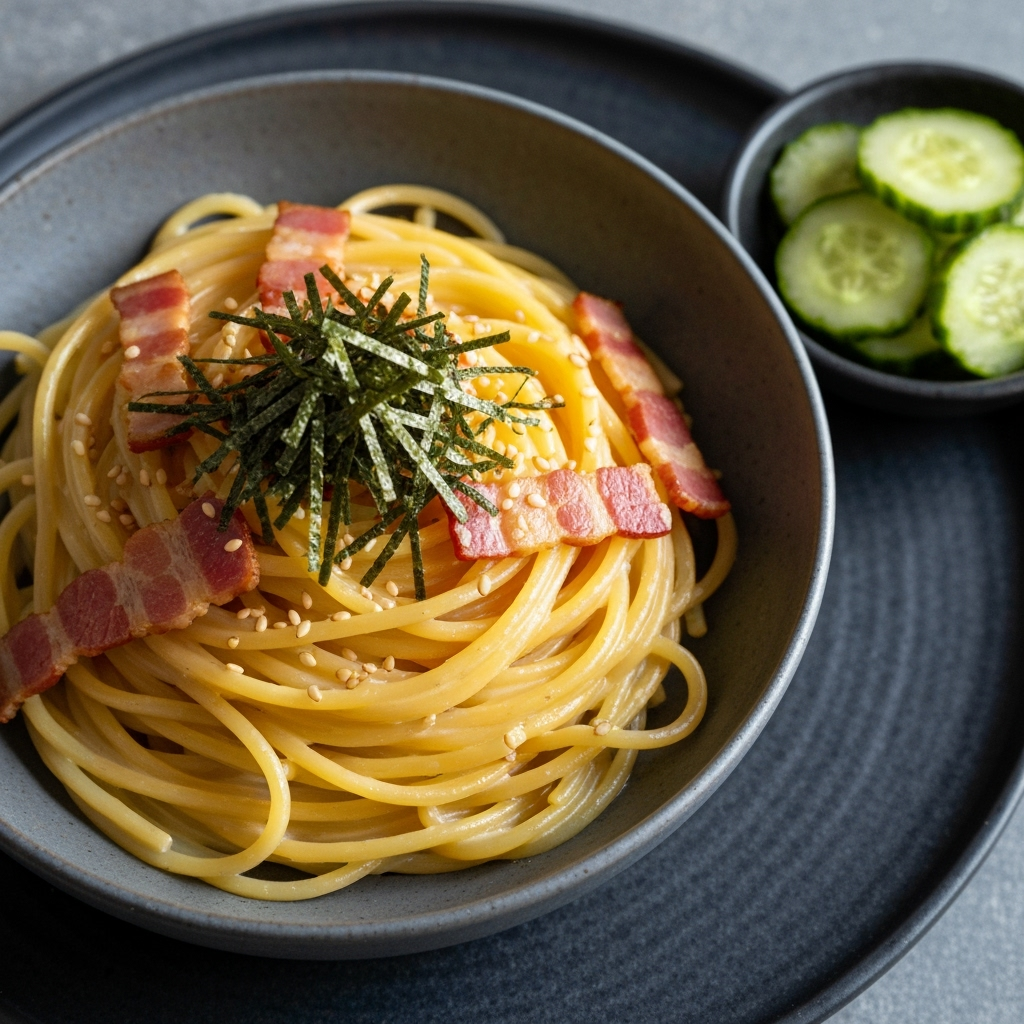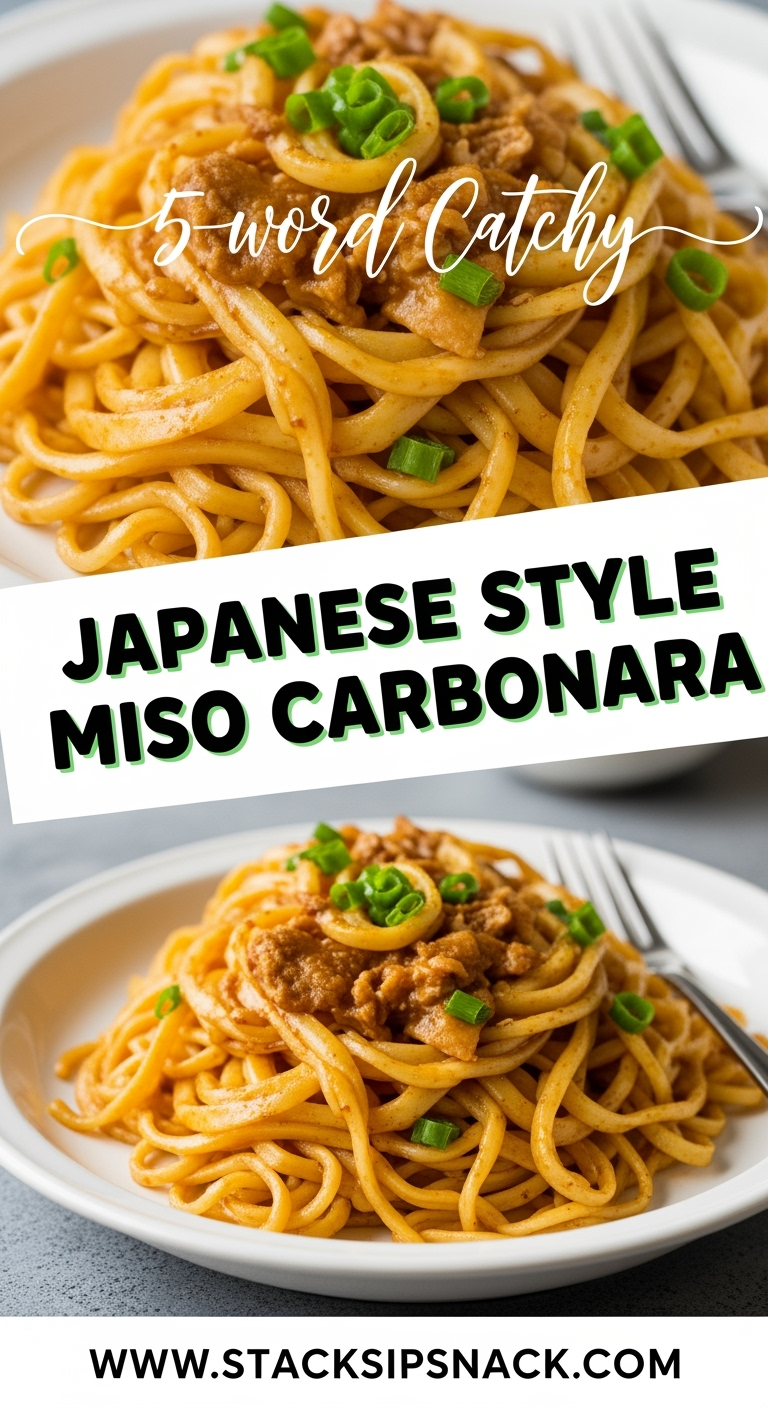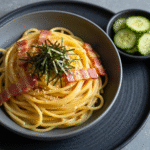Japanese-Style Miso Carbonara is the kind of recipe that happens by accident, born from a late-night fridge raid and a stubborn refusal to order takeout. I was craving the creamy, comforting embrace of a classic carbonara but found myself staring at an almost empty carton of eggs and a lonely tub of miso paste. The bacon was there, thankfully. In a moment of what I can only call hungry inspiration, I decided to swap the traditional Pecorino Romano for the deep, savory funk of white miso. The result was nothing short of magic. This Japanese carbonara isn’t just a substitute for the real thing; it’s a brilliant, umami-packed pasta fusion that stands proudly on its own. It’s the perfect dish for when you want something familiar yet excitingly different, all in under 30 minutes.
Table of Contents
Japanese-Style Miso Carbonara Ingredients
The foundation of this incredible Japanese-Style Miso Carbonara is a short list of simple, high-impact ingredients that work together to create a symphony of umami. 
- 8 ounces (225g) spaghetti or bucatini
- 4 slices thick-cut bacon, chopped (or pancetta)
- 2 large eggs
- 1/4 cup heavy cream
- 2 tablespoons white miso paste
- 2 cloves garlic, minced
- 1/4 cup reserved pasta water
- 1 tablespoon unsalted butter
- Freshly cracked black pepper
- Sliced green onions, for garnish
- Shredded nori or toasted sesame seeds, for garnish (optional)
Smart Swaps:
- Pasta: Any long pasta works. For a different texture, try this with the udon noodles from our Decadent Creamy Miso Udon.
- Bacon: Use pancetta for a more traditional carbonara feel, or try diced shiitake mushrooms for a vegetarian version.
- Heavy Cream: For a lighter sauce, half-and-half or whole milk can be used, though the sauce will be slightly less rich.
Recipe Timing
- Prep time: 10 minutes
- Cook time: 15 minutes
- Total time: 25 minutes
This comes together about 30% faster than many traditional sauce-making processes, making it a true weeknight hero.
Step-by-Step Instructions for Miso Carbonara
Creating the perfect creamy miso sauce is easier than you think. The key is preparation and a confident, quick hand when combining everything at the end.
- Cook the Pasta: Bring a large pot of generously salted water to a boil. Add the spaghetti and cook according to package directions until al dente. Just before draining, scoop out about 1/4 cup of the starchy pasta water. This liquid gold is essential for saucing.
- Crisp the Bacon: While the pasta cooks, place the chopped bacon in a large, cold skillet. Turn the heat to medium and cook, stirring occasionally, until the bacon is crispy and the fat has rendered, about 5-7 minutes. Use a slotted spoon to remove the bacon, leaving the beautiful rendered fat in the pan.
- Infuse the Aromatics: Add the minced garlic to the bacon fat in the skillet. Cook for just 30-60 seconds until fragrant. Be careful not to burn it. Turn off the heat.
- Create the Sauce Base: In a medium bowl, whisk together the eggs, heavy cream, and white miso paste until completely smooth and lump-free. This is your creamy, umami power base.
- Combine and Emulsify: This is the most important step. Add the hot, drained pasta directly to the skillet with the garlic-infused bacon fat. Also add the tablespoon of butter and the reserved pasta water. Toss vigorously over low heat—the residual heat is perfect here. The goal is to create an emulsified sauce that clings to the pasta.
- Temper the Eggs: Remove the skillet from the heat entirely. Slowly pour the egg and miso mixture into the pasta, tossing continuously and quickly. The heat from the pasta will cook the eggs gently, creating a luxuriously creamy sauce without scrambling them.
- Finish and Serve: Stir in most of the crispy bacon, saving some for garnish. Season generously with black pepper. Divide into bowls and top with green onions, the remaining bacon, and a sprinkle of shredded nori or sesame seeds if using.
Nutritional Information (per serving)
This recipe makes 2 generous servings. Each serving contains approximately:
- Calories: 680
- Protein: 25g
- Carbohydrates: 65g
- Fat: 34g
- Sodium: 1150mg
Miso is a fermented food, rich in probiotics and essential minerals like zinc and manganese, while eggs provide high-quality protein and choline.
Equipment Needed for Japanese Carbonara
You don’t need any fancy gadgets for this fusion pasta recipe. A few basics will do the trick:
- Large pot for boiling pasta
- Large skillet (preferably non-stick or well-seasoned cast iron)
- Whisk
- Tongs or pasta fork for tossing
- Measuring cups and spoons
- Small bowl for mixing the sauce
Why You’ll Love This Japanese-Style Miso Carbonara
This dish is a guaranteed win for your recipe rotation. Here’s why it will become a fast favorite:
- Explosion of Umami: The combination of salty bacon, funky miso, and rich egg creates a deep, savory flavor profile that is incredibly satisfying.
- Surprisingly Simple: It looks and tastes gourmet, but the process is straightforward and quick, perfect for a busy weeknight.
- The Best of Both Worlds: It satisfies the craving for Italian comfort food while introducing an exciting, modern Japanese twist.
- Endlessly Adaptable: As you’ll see in the next section, this recipe is a fantastic canvas for dietary tweaks and personal preferences. If you enjoy this kind of adaptable noodle dish, you might also love our Katsu Curry Udon.
Healthier Alternatives for Miso Carbonara
This umami pasta is wonderfully flexible. Here are some easy swaps to fit your dietary needs without losing the soul of the dish.
- Gluten-Free: Use your favorite gluten-free spaghetti. The sauce is naturally gluten-free as long as your miso paste is certified GF.
- Dairy-Free/Lighter: Replace the heavy cream with full-fat canned coconut milk for a rich, dairy-free alternative. You can also omit the butter.
- Vegetarian: Omit the bacon and start by sautéing the garlic in 2 tablespoons of olive oil or sesame oil. For a savory, meaty texture, add sautéed mushrooms or a sprinkle of coconut bacon.
- Higher Protein: Add a soft-boiled or poached egg on top of each serving for an extra protein boost. For another quick, protein-packed noodle idea, check out our Easy 20-Min Soy Egg Udon Stir Fry.

Serving Suggestions for Your Umami Pasta
This Japanese carbonara is a complete meal in a bowl, but a few simple additions can make it even more special.
- With Veggies: Serve with a simple side of steamed edamame, a crisp cucumber salad with a rice vinegar dressing, or some quickly sautéed bok choy.
- For a Crowd: Double the recipe and serve it family-style in a large, warm bowl. Let everyone garnish their own portion with extra green onions and nori.
- The Perfect Drink Pairing: A crisp, dry sake or a light lager beer complements the rich, savory notes beautifully. For a non-alcoholic option, chilled green tea or sparkling water with lemon is perfect.
Common Mistakes to Avoid with Miso Carbonara
A few small missteps can affect your final dish. Here’s how to avoid them:
- Scrambled Eggs: The number one fear! Always remove the pan from the heat before adding the egg mixture, and toss continuously. The residual heat is enough to cook the eggs into a silky sauce.
- Lumpy Miso Sauce: Whisk the miso paste into the eggs and cream thoroughly until no lumps remain before it hits the pasta.
- Skipping Pasta Water: The starchy pasta water is non-negotiable. It helps bind the sauce to the pasta and creates the perfect creamy consistency. Don’t forget to reserve it!
- Overcooking the Garlic: Burnt garlic tastes bitter. Cook it just until fragrant in the residual heat of the bacon fat.
Storing Tips for Your Fusion Pasta Recipe
This dish is best enjoyed immediately, but leftovers can be saved.
- Refrigeration: Store any leftovers in an airtight container in the refrigerator for up to 2 days.
- Reheating: Reheat gently in a skillet over low heat, adding a splash of water, cream, or milk to loosen the sauce. Avoid the microwave, as it can cause the eggs to curdle and the sauce to separate.
- Freezing: Unfortunately, this dish does not freeze well due to the creamy egg sauce, which will separate and become grainy upon thawing.

Final Thoughts on Japanese-Style Miso Carbonara
This Japanese-Style Miso Carbonara is more than just a pasta dish; it’s a delicious proof that some of the best culinary creations come from a little experimentation. It brings the comfort of Italy and the profound umami of Japan together in one incredibly satisfying bowl. Whether you’re a carbonara purist looking to branch out or a miso lover seeking new applications, this recipe delivers on every level. It’s quick, it’s unique, and it’s guaranteed to impress.
I truly hope this recipe brings as much joy to your table as it has to mine. If you’re a fan of creamy, savory noodle dishes, you should definitely explore our Creamy Gochujang Udon Noodles for another fantastic flavor adventure.
I’d love to hear how your Japanese carbonara turned out! Leave a comment below and tell me about your experience. And don’t forget to share your creations by tagging @Stacksipsnack on Pinterest
FAQs about Japanese-Style Miso Carbonara
What is Japanese-style Miso Carbonara?
Japanese-style Miso Carbonara is a fusion pasta dish that blends the creamy, indulgent sauce of Italian carbonara with the distinctive umami and savory depth of Japanese miso paste. It typically incorporates traditional carbonara elements like eggs, cheese, and cured pork, but with the added complexity and saltiness of miso, sometimes enhanced with dashi or other Japanese seasonings.
What kind of miso is best for Miso Carbonara?
For Japanese-style Miso Carbonara, u003cstrongu003ewhite miso (shiro miso)u003c/strongu003e is generally recommended. Its milder, sweeter, and less salty profile blends smoothly into the sauce without overpowering the other ingredients, contributing a balanced umami. Red miso (aka miso) can be used sparingly for a bolder, saltier flavor, but it requires careful balancing.
How does Japanese-style Miso Carbonara differ from traditional Carbonara?
The primary difference is the inclusion of u003cstrongu003emiso pasteu003c/strongu003e, which imparts a unique umami, savory-sweetness, and depth to the sauce, distinct from traditional carbonara’s reliance on Pecorino Romano and guanciale. Japanese versions might also use dashi, sake, or mirin, and sometimes incorporate toppings like scallions or nori, departing from the classic Roman ingredients.
What ingredients are typically in Japanese-style Miso Carbonara?
Key ingredients include pasta (often spaghetti), eggs (yolks or whole eggs), grated cheese (Parmesan or Pecorino), cured pork (bacon or pancetta), garlic, and black pepper. The Japanese twist comes from u003cstrongu003emiso pasteu003c/strongu003e, often white miso, and sometimes a splash of dashi, mirin, or sake. Garnishes like chopped scallions or shredded nori are also common.
Can I make Japanese-style Miso Carbonara vegetarian or vegan?
Yes, you can. For a vegetarian version, simply omit the cured pork (bacon/pancetta) and ensure your cheese is vegetarian-friendly. For a vegan version, replace the eggs with a plant-based creamy sauce (e.g., silken tofu, cashew cream, or nutritional yeast), use plant-based bacon alternatives or mushrooms for texture, and opt for a vegan cheese substitute, confirming your miso paste is also vegan-certified.
How do you prevent Miso Carbonara from becoming grainy or curdling?
To prevent curdling, the key is u003cstrongu003egradual emulsification and controlled heatu003c/strongu003e. Ensure your cooked pasta is piping hot but removed from direct heat before adding the egg-miso mixture. Slowly incorporate the egg sauce while continuously tossing the pasta, using a splash of starchy pasta water to create a smooth, creamy sauce. Avoid overheating the eggs, which can cause them to scramble or become grainy.

Japanese-Style Miso Carbonara
- Total Time: 25 minutes
- Yield: 2 servings 1x
Description
Japanese-Style Miso Carbonara is the kind of recipe that happens by accident, born from a late-night fridge raid and a stubborn refusal to order takeout. This Japanese carbonara isn’t just a substitute for the real thing; it’s a brilliant, umami-packed pasta fusion that stands proudly on its own. It’s the perfect dish for when you want something familiar yet excitingly different, all in under 30 minutes.
Ingredients
- 8 ounces (225g) spaghetti or bucatini
- 4 slices thick-cut bacon, chopped (or pancetta)
- 2 large eggs
- 1/4 cup heavy cream
- 2 tablespoons white miso paste
- 2 cloves garlic, minced
- 1/4 cup reserved pasta water
- 1 tablespoon unsalted butter
- Freshly cracked black pepper
- Sliced green onions, for garnish
- Shredded nori or toasted sesame seeds, for garnish (optional)
Instructions
- Cook the Pasta: Bring a large pot of generously salted water to a boil. Add the spaghetti and cook according to package directions until al dente. Just before draining, scoop out about 1/4 cup of the starchy pasta water.
- Crisp the Bacon: While the pasta cooks, place the chopped bacon in a large, cold skillet. Turn the heat to medium and cook, stirring occasionally, until the bacon is crispy and the fat has rendered, about 5-7 minutes. Use a slotted spoon to remove the bacon, leaving the rendered fat in the pan.
- Infuse the Aromatics: Add the minced garlic to the bacon fat in the skillet. Cook for just 30-60 seconds until fragrant. Be careful not to burn it. Turn off the heat.
- Create the Sauce Base: In a medium bowl, whisk together the eggs, heavy cream, and white miso paste until completely smooth and lump-free.
- Combine and Emulsify: Add the hot, drained pasta directly to the skillet with the garlic-infused bacon fat. Also add the tablespoon of butter and the reserved pasta water. Toss vigorously over low heat.
- Temper the Eggs: Remove the skillet from the heat entirely. Slowly pour the egg and miso mixture into the pasta, tossing continuously and quickly.
- Finish and Serve: Stir in most of the crispy bacon, saving some for garnish. Season generously with black pepper. Divide into bowls and top with green onions, the remaining bacon, and a sprinkle of shredded nori or sesame seeds if using.
Notes
This dish is best enjoyed immediately. Store leftovers in an airtight container in the refrigerator for up to 2 days. Reheat gently in a skillet over low heat, adding a splash of water, cream, or milk to loosen the sauce. Avoid the microwave. This dish does not freeze well.
- Prep Time: 10 minutes
- Cook Time: 15 minutes
- Category: Main Course
- Method: Stovetop
- Cuisine: Japanese-Italian Fusion
Nutrition
- Serving Size: 1 serving
- Calories: 680
- Sugar: 5g
- Sodium: 1150mg
- Fat: 34g
- Saturated Fat: 15g
- Unsaturated Fat: 16g
- Trans Fat: 0g
- Carbohydrates: 65g
- Fiber: 3g
- Protein: 25g
- Cholesterol: 250mg
💬 Let’s Stay Connected!
For daily recipes, kitchen tips, and exclusive content, follow me on:
👉 Facebook for behind-the-scenes & community fun
👉 Pinterest for visual inspiration & meal ideas
👉 X (Twitter) for quick tips & trending recipes
📲 Join the flavor journey, your next favorite recipe is just a follow away!










